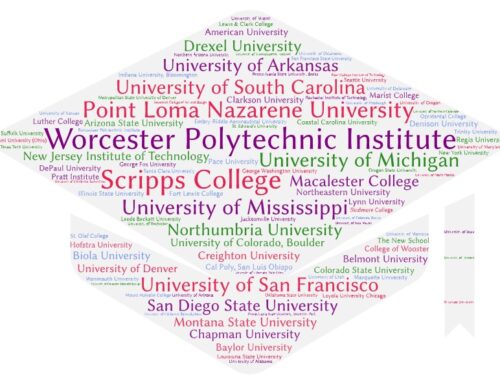This is my third in a series of blog posts on the increasing cost of college in the United States. In the first post, I offered several reasons why college is so expensive. In the second, I explained that college may not actually be as costly as it seems, as most families don’t pay full price because they receive need- and/or merit-based aid. In this post, I will explore a new trend of colleges lowering their tuition.
Yes, you read that right: in the last couple years, while most colleges have increased their tuition, a small number of private schools have reduced theirs by a significant amount. For example, Colby-Sawyer College in New Hampshire cut its 2023-2024 tuition by 62%, from about $46,000 to $17,500. Other colleges that have done a “tuition reset,” as it’s called, include Lasell University, Washington & Jefferson College, Roanoke College, Houghton University, and Fairleigh Dickinson University.
If you’ve never heard of most or all of these colleges, that points to the very reason why they’ve cut their tuition: they aren’t prestigious or well-known enough for students and their families to be willing to pay top dollar. A recent New York Times article explained that prior to the tuition reset, Colby-Sawyer awarded every student a scholarship, yet, according to its president, “Many potential applicants . . . balked at the sticker price, and did not investigate further.”
Even some public colleges have reduced their price: Vermont State University lowered its in-state tuition to $9,999, which represents an average decrease of 15% across its multiple campuses, and it cut out-of-state tuition by 33%. Others are freezing tuition: Purdue University hasn’t raised theirs since 2012, and many state university systems, including those in New York, Virginia, Nebraska, Wisconsin, South Carolina and Tennessee, have enacted tuition freezes.
This recent trend of resetting tuition is similar to one I described in my second blog post on why college is so expensive: in the 1980s and 1990s, many private schools started offering merit scholarships as an incentive for students whose families could afford their list prices but who didn’t feel that such schools were worth it. Whereas a family might be willing to pay the full cost of attendance at an Ivy (none of which offer merit aid), they might not be willing to pay it at a less selective private school. Thus, the concept of the merit scholarship was born.
Like Colby-Sawyer, a number of moderately and less selective private colleges award scholarships to most or all students. In 2022, the National Association of College and University Business Officers surveyed 359 private nonprofit colleges and found that the average tuition discount at these schools for first-time, full-time freshmen was 54.5%. For all undergraduates, it was 49%. The schools surveyed offered grant aid to 82.5% of undergraduates in the 2021-22 school year and the awards covered an average of 60.7% of published tuition and fees.
Colleges offer abundant scholarships rather than reducing their tuition because they fear that a lower price will be interpreted by students and families to indicate lower quality. But perhaps, now that a number of schools have reset their tuition, more will follow suit. Just don’t expect the most selective colleges to do so. According to the aforementioned New York Times article, “Analysts say tuition resets are unlikely to extend to the smaller subset of more competitive schools, ones with robust endowments and bigger applicant pools.”






